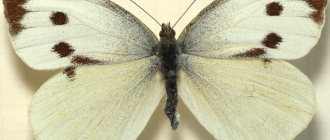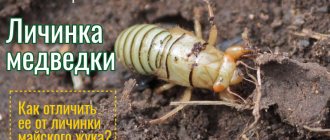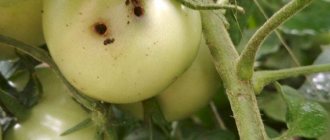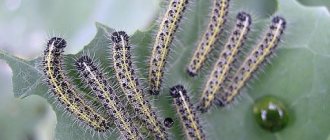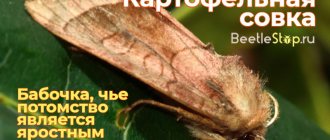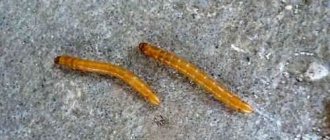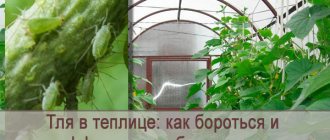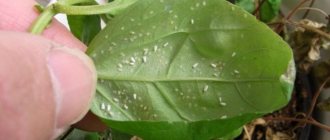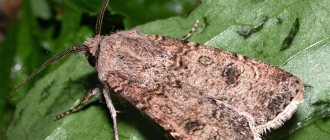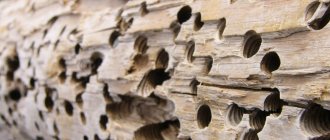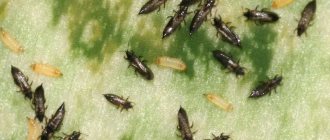An unremarkable butterfly - the cabbage cutworm - has long chosen human fields and vegetable gardens as a breeding ground, and agricultural crops as a source of food for voracious caterpillars. This pest is distributed throughout the European continent and is well known to people. Therefore, today there are effective ways to combat it.
Cabbage cutworm: description, appearance, life cycle
The cabbage armyworm (Mamestra brassicae) is a butterfly of the moth family, order Lepidoptera. The body length is 19-23 mm, its wingspan is 40-50 mm.
The front wings of the cutworm are gray-brown in color with a pattern of curved yellow lines; the leading edge has dark spots and a pattern with a double row of zigzags. The hind wings are darker: brown or gray.
The lifespan of the female is 2-3 weeks.
The mating period begins 2-3 days after the butterflies emerge from the pupae. The female lays eggs on the underside of leaves in batches. One clutch can contain 20-150 eggs. The fertility of females is 600-2700 eggs.
Armyworm eggs are slightly oblong in shape and white in color, their diameter is 0.6-0.7 mm. The egg stage lasts 4-12 days.
The caterpillar develops in 24-50 days, depending on air temperature and soil moisture. The larva molts five times and goes through six instars. An adult caterpillar is 5 cm long. It has 16 legs. The color of the larva can vary: from light green to dark brown. There are black stripes on the back.
Armyworm larvae feed on cabbage, legumes, beets, lettuce, onions, etc. At the first instar, they feed on the leaves from below, leaving the upper part intact. In the second and third instars, the caterpillars gnaw holes, and in older instars they eat up the leaves almost completely, leaving only large veins.
After the caterpillar stage comes the pupa stage. The larvae of the first generation pupate at the end of June, and the second - in September-October. The pupa overwinters in the ground at a depth of 10-25 cm. The length of the pupa is 19-24 mm.
When the air temperature warms up to 16-17°C, that is, at the end of spring - at the beginning of summer, a butterfly emerges from the pupa.
Advantages of the drug:
- an original combination of two active ingredients that differ in their mechanism of action;
- combination of speed of action and long period of protection;
- triple action – contact, intestinal and systemic;
- destruction of hidden pests and those feeding on the underside of leaves;
- effectiveness against pest populations resistant to pyrethroids and organophosphorus compounds;
- resistance to prolonged exposure to intense sunlight and heat.
Why is cabbage cutworm harmful?
Butterflies are safe for the harvest: adults feast on nectar at dusk. But the cabbage moth caterpillar is quite voracious and eats cabbage, and it can just deprive the harvest.
The cabbage cutworm larvae of the third instar feed on the pulp of the leaves, while the larvae of the fourth and fifth instars eat the cobs, forming tunnels in them. In addition, the caterpillars deposit excrement in the cabbage, which leads to rotting of the heads of cabbage.
If you do not fight the cabbage cutworm, you can completely lose the harvest.
The cabbage cutworm feeds not only on cabbage, it can also feast on beets, poppy seeds, corn, legumes, sunflowers, tobacco, sesame seeds, sage, radishes, cloves, chrysanthemums, potatoes, tomatoes, carrots, flax, buckwheat, etc. It can cause harm fruit trees and ornamental plants.
Depending on the region, the moth can be found at different times: in the center and northwestern part of Russia, butterflies can be seen in early June, and in the Volga region and the North Caucasus - already in May. For this reason, it is especially dangerous for the southern regions: the armyworm manages to degenerate in two generations, which means that the caterpillars appear twice per season.
Cabbage cutworm, caterpillar, green form
Cabbage cutworm, caterpillars, dark form
Cabbage cutworm, caterpillars, various forms
Causes and signs of appearance
You can suspect the activity of cabbage cutworm when examining the plant. On seedlings, the insect actively gnaws the stems, so the crop falls. Cabbage cutworm larvae cause such damage.
During the day, the caterpillars gradually make their way to the base of the head of cabbage so that with the onset of autumn they can eat their way through. As a result of their harmful actions, the crop is contaminated with excrement. You may not see the cutworm from the outside, but if you cut a vegetable, there will be black spots and caterpillars inside it. This type of cabbage is not suitable for human consumption. There is no point in sending a vegetable damaged by scoops for winter storage: it will quickly rot.
Cutworm larvae gnaw holes on the leaves, leaving only thick veins
If no measures are taken, the insect completely destroys the plant, which, after losing its foliage, begins to rot from the inside. With minor damage, vegetables slow down their growth and become sick for a long time.
The main reason for the appearance of cutworms on cabbage is the availability of food. The butterfly's attention is attracted by the smell of hay, cereals and mixed feed. The pest can often be seen near grain warehouses.
Important! The abundance of weeds on the site provides the insect with a favorable environment for development and reproduction.
Cabbage cutworm: how to get rid of it on the site?
To get rid of the pest, you can use different methods: collect insects by hand, use pesticides, traps and decoctions. Each method has its own advantages and disadvantages. Let's take a closer look at various ways to get rid of cabbage cutworms.
Mechanical methods of fighting armyworms
The easiest way to reduce pests is by hand picking.
Regularly, every week, it is necessary to inspect the cabbage leaves. All discovered clutches of eggs and larvae must be destroyed. The optimal time for collecting caterpillars is early twilight, when the larvae emerge from their hiding places in search of food.
Manual collection of insects is considered an ineffective method of pest control. It will help reduce the number of armyworms on the site, but it is impossible to completely get rid of them. If you do not use other methods or skip at least a few weeks of collecting pests, the population will completely recover, and all your work will be in vain.
To get rid of cutworm pupae, it is necessary to loosen the soil to a depth of at least 10 cm before winter.
Chemical methods of fighting armyworms
To destroy pests, the most effective method is the use of chemicals.
The following means are suitable for combating armyworms:
- Iskra-M;
- Inta-Vir;
- Sherpa;
- Kinmiks;
- Fas;
- Bankolom;
- Zeta et al.
Insecticides should be sprayed at sunset in calm and rainy weather. Chemicals can be used no more than twice per season.
The use of insecticides must be stopped a month before harvesting cabbage, otherwise there is a risk of fruit poisoning later.
Biological methods of combating armyworm
Using biological agents is a safer way to get rid of pests compared to chemicals.
The following biological agents will be effective against armyworms:
- Lepidocide;
- Bitoxibacillin;
- Fitoverm et al.
Biological products do not harm humans or processed fruits. But their use has its own rules: treatment with biological agents must be completed no less than 5 days before the start of harvest.
Cabbage cutworm, caterpillar and butterfly
How to fight with folk remedies
And although the cabbage cutworm caterpillar in the photo does not cause concern, getting rid of it is not so easy. To achieve maximum effect, it is recommended to use several methods, combining them with each other.
Folk remedies are popular not only because of their effectiveness, but also their harmlessness. Ready-made solutions are safe for human health and plants on the site. The advantage of traditional methods is their accessibility: most components are free or have a low cost.
To catch cabbage cutworms, you can use not only infusions, but also traps. To make them, just stock up on disposable cups or bottles that need to be trimmed, leaving sides 3 cm high. Fill the resulting containers with sweet liquid and hang them 1 m from the ground.
To prepare cabbage scoop syrup, mix 50 g of yeast with 1 liter of water. When the solution has fermented, add 1000 ml of flow and another 3 liters of water. Distribute the finished substance into containers. You can use compote or jam as a sweet liquid.
Important! Insect traps should be refilled with solution periodically. Once every two weeks, the contents of the container must be completely changed.
To prevent insects from escaping from the trap, the cut part of the bottle can be placed back into the container with the neck down.
Hot pepper solution
To use this product, you need to take 100 g of pods, fill them with 1 liter of water and put on fire. Boil the solution for 60 minutes. Cool the resulting remedy for cabbage cutworms, strain, and leave to infuse under the lid for two days.
It is convenient to spray plants against insects using a spray bottle, diluting the liquid in a ratio of 1:10 with water.
Liquid soap with wormwood from cabbage scoop
To obtain a solution, flowering wormwood must be crushed. Fill it with a bucket of hot water. Boil the raw material for 15-20 minutes, and then let it cool for six hours. Add 1 tbsp to the prepared remedy for cabbage cutworms. l. liquid soap. Shake the container with the mixture thoroughly before use.
Ash solution
Mix 200 g of nitrogen fertilizer and tobacco waste with 30 g of melted soap and 15 g of mustard. Pour boiling water over all components of the product, bringing it to 10 liters, and then leave the pan with the contents for one day. The ready-made preparation for cabbage cutworm can be used to treat vegetable crops.
Herbal infusion
Fill the bucket halfway with burdock leaves and compact them tightly. Fill the container to the brim with water. Leave the infusion in this position for 72 hours, and then strain it. It does not need to be diluted with water to use. To prevent the product from rolling off the leaves, it is best to add laundry soap to it.
As a substitute for burdock, you can use chamomile, datura or spurge
Cabbage scoop soda
The emulsion consists of only two components. To obtain it, you need to dissolve a glass of soda in a bucket of water. Spray the plant with the prepared cabbage cutworm remedy.
Dandelion infusion
Add 500 g of raw materials to 10 liters of water. You can use crushed leaves and shoots, roots and flowers. Add 1 tbsp to the resulting solution. l. liquid soap and leave it to sit overnight before use.
Tomato infusion
Chop green tomato stems. Mix them with bitter wormwood. To 10 liters of boiling water you need to add 350 g of the resulting mixture, and then leave all the components to infuse for six hours.
Bird droppings with wormwood
Boil 1 kg of herb in 3 liters of water. Two days before use, add 100 g of bird droppings to the infusion. Dilute the resulting remedy for cabbage cutworms with water to 10 liters, and then use it for its intended purpose.
Recommendations for use:
Against seedling pests, for example, cruciferous flea beetles, etc., crops are sprayed with Borey® on seedlings, against other types of harmful insects - during the growing season of crops, when pests appear on the field in quantities exceeding the economic threshold of harmfulness. Areas inhabited by locusts are treated during the period of mass hatching of larvae.
It is recommended to add an adjuvant (for example, Allure® or Polyphem®) to the working solution of the insecticide, which will ensure high-quality and uniform coverage of plant leaves with the working solution of the drug.
| Culture, object | Pest | Consumption rate of the drug, l/ha |
| Spring wheat | Bug bug, flea beetles, grain flies | 0,08 — 0,12 |
| Gray fall armyworm (younger caterpillars) | 0,1 — 0,12 | |
| Winter wheat | Cereal flies | 0,08 — 0,1 |
| Bug harmful turtle | 0,08 — 0,12 | |
| Spring barley | Cereal flies | 0,08 — 0,12 |
| Rape | Rapeseed flower beetle, cruciferous flea beetle | 0,06 — 0,1 |
| Potato | Colorado beetle | 0,08 — 0,1 |
| Peas | Pea weevil, aphids | 0,12 — 0,15 |
| Tomatoes | Colorado potato beetle, whitefly | 0,1 — 0,2 |
| Onion | Onion fly | 0,1 — 0,2 |
| Carrot | carrot fly | 0,1 — 0,2 |
| Cabbage | Cruciferous flea beetles, turnip moth, cabbage cutworm | 0,1 — 0,2 |
| Apple tree | Apple codling moth, leaf rollers | 0,3 |
| Grape | Leaf rollers | 0,3 |
| Areas infested with locusts | Italian Locust, Asiatic Locust, Moroccan Locust | 0,1 — 0,2 |
Symptoms
Small larvae feed on the underside of the outer leaves, where they make small perforations. As the larvae age, the feeding holes become larger. Severe infestations of small larvae can quickly skeletonize leaves and sometimes destroy small plants. Old larvae tunnel into the heart of the plants. They leave behind significant amounts of feces, which encourage the growth of decaying bacteria and fungi. Most crop losses caused by larvae are a result of contamination rather than the amount of plant tissue eaten. Even minor infestations of maggots can be harmful, especially in crops such as cabbage where the grubs destroy marketable produce.
In cauliflower and broccoli, the larvae also feed on the inflorescence, where they chew more or less deep holes. The small larvae are well hidden between flower stems and can undergo sorting procedures, contaminating processed foods.
Soybean leaves can be completely skeletonized. Feeding can destroy young buds, resulting in distorted growth. The larvae penetrate the pods and feed on the seeds.
The larvae feed on the leaves, buds and petals of ornamental plants such as dahlias, chrysanthemums and roses, and can penetrate the fruits of fruit crops such as tomatoes.
Agricultural significance
The cabbage butterfly is found throughout Europe, temperate regions of Asia and some places in North Africa. It is absent in the Americas.
Although the extent of cabbage moth infestation varies between years in the northernmost and southernmost parts of its range, it is an important pest in its central areas where it can cause serious damage. In some cases, losses of up to 80% have been reported.
Control
Cultural control includes integrated weed management. Thorough plowing after harvest in the fall will destroy most of the pupae, exposing them to predators and frost.
Provided there are no pupae already in the soil, covering the beds with a 1.5-2mm net before the plants emerge or immediately after planting will largely prevent infestation. Early ripening cabbage is less susceptible to infection because the heads are already well developed by the time the larvae appear.
Red cabbage was found to be less infested with maggots than white cabbage and savoy cabbage. Different varieties of white cabbage, red cabbage and savoy cabbage vary in their susceptibility to M. brassicae. The red leaf variety of Brussels sprouts has been found to show some resistance to M. brassicae.
Morphology
Imago . A butterfly with a body length of 19–23 mm. [5] Wingspan – 40–50 mm. The forewings are dark brown with dark transverse lines. The kidney-shaped spot is surrounded by white or partially white. The submarginal line is yellow-white with two teeth in the shape of the letter M. The hind wings are gray, darker at the edges. [1]
Sexual dimorphism Individuals of different sexes differ in the structure of their genital organs. [10]
The egg is yellowish-white with 32–38 radially directed ribs. Diameter – 0.6–0.7 mm. [1]
The larva (caterpillar) , like all representatives of the noctuid family, has five pairs of abdominal legs equipped with single-tiered or double-tiered hooks located on the sole in a medial row. [8]
Length – 35–40 mm. The color is variable - from grayish-green to dark brown or almost black. On the dorsal side there is a pattern of dark spots in the form of a herringbone, which is especially well expressed on the last segments of the abdomen. The sides of the body are yellowish with light stripes. [1]
The pupa is 19–24 mm long, the integument is red-brown. The cremaster has two long touching projections ending in a flattened club. [1]
Phenology of development (in days)
Babanukha
Babanukha is a dark greenish insect with brownish legs. The insect eats almost all varieties of plants, including cabbage. The leaf beetle waits out the winter under fallen leaves, in manure granules.
In early June, this beetle leaves its wintering site and begins to eat cabbage leaves. Females are able to form depressions in cabbage leaves, in which eggs can later be found.
To escape from this type of pest, use the following:
- painstakingly destroy all traces of plants during the harvesting process;
- get rid of unnecessary plants;
- do not leave radishes and mustard to grow;
- plant seedlings early;
- in the autumn, dig up the ground in the area with seedlings.
Pest control methods
Cutworms emerge after wintering in late spring or June. Butterflies reproduce very quickly: they hatch a large number of eggs at a time. The caterpillars emerge from the egg after 4-12 days. As they develop, they cause more and more damage to the crop.
The fight against cabbage cutworm is carried out using various methods:
- agrotechnical;
- mechanical;
- chemical;
- biological.
The methods are used comprehensively. To prevent the development of pests, agrotechnical and chemical methods are used.
Agrotechnical method
Caterpillar populations can be reduced
If agrotechnical work is carried out correctly before planting, the development of pests can be prevented. To combat the armyworm, the following measures are taken:
- Carrying out deep autumn plowing. Weed seedlings are destroyed, fertilizers are plowed deeper, and soil moisture increases. The root system of plants develops better, and their overall resistance to pests increases.
- Row-spacing cultivation. The method involves periodically loosening the soil and removing weeds.
Weeds provide a convenient place for egg laying, as well as a breeding ground for young caterpillars, so weed control helps reduce the caterpillar population in the area.
Mechanical method
The simplest and safest way to combat cabbage cutworm is mechanical, but it is convenient to use only in small areas.
The mechanical method involves collecting discovered caterpillar eggs by hand. After collection, the insects are destroyed.
Collecting insects is carried out with gloves. The cabbage is carefully inspected. Early varieties are damaged superficially by young larvae: they can be found on the leaves (usually on the inside). Late varieties are inspected for the presence of insects immediately so that the caterpillars do not have time to penetrate inside.
